您好,登錄后才能下訂單哦!
您好,登錄后才能下訂單哦!
0.引言
利用python開發,借助Dlib庫捕獲攝像頭中的人臉,提取人臉特征,通過計算歐氏距離來和預存的人臉特征進行對比,達到人臉識別的目的;
可以自動從攝像頭中摳取人臉圖片存儲到本地,然后提取構建預設人臉特征;
根據摳取的 / 已有的同一個人多張人臉圖片提取128D特征值,然后計算該人的128D特征均值;
然后和攝像頭中實時獲取到的人臉提取出的特征值,計算歐氏距離,判定是否為同一張人臉;
人臉識別 / face recognition的說明:
wikipedia 關于人臉識別系統 / face recognition system 的描述:theywork by comparing selected facial featuresfrom given image with faces within a database.
本項目中就是比較 預設的人臉的特征和 攝像頭實時獲取到的人臉的特征;
核心就是提取128D人臉特征,然后計算攝像頭人臉特征和預設的特征臉的歐式距離,進行比對;
效果如下(攝像頭認出來我是default_person預設的人臉 / 另一個人不是預設人臉顯示diff):
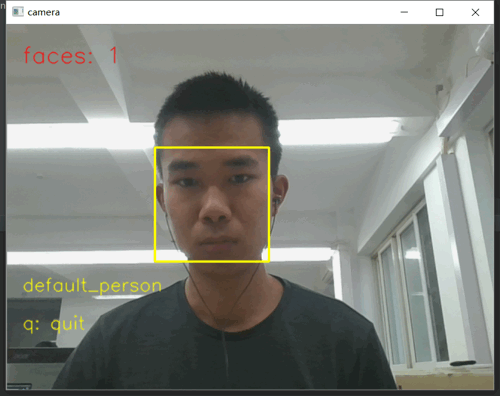
圖1 攝像頭人臉識別效果gif
1.總體流程
先說下 人臉檢測 (face detection) 和 人臉識別 (face recognition) ,前者是達到檢測出場景中人臉的目的就可以了,而后者不僅需要檢測出人臉,還要和已有人臉數據進行比對,識別出是否在數據庫中,或者進行身份標注之類處理,人臉檢測和人臉識別兩者有時候可能會被理解混淆;
我的之前一些項目都是用dlib做人臉檢測這塊,這個項目想要實現的功能是人臉識別功能,借助的是 dlib官網中 face_recognition.py這個例程 (link:http://dlib.net/face_recognition.py.html);
核心在于 利用 “dlib_face_recognition_resnet_model_v1.dat” 這個model,提取人臉圖像的128D特征,然后比對不同人臉圖片的128D特征,設定閾值計算歐氏距離來判斷是否為同一張臉;
# face recognition model, the object maps human faces into 128D vectors
facerec = dlib.face_recognition_model_v1("dlib_face_recognition_resnet_model_v1.dat")
shape = predictor(img, dets[0])
face_descriptor = facerec.compute_face_descriptor(img, shape)
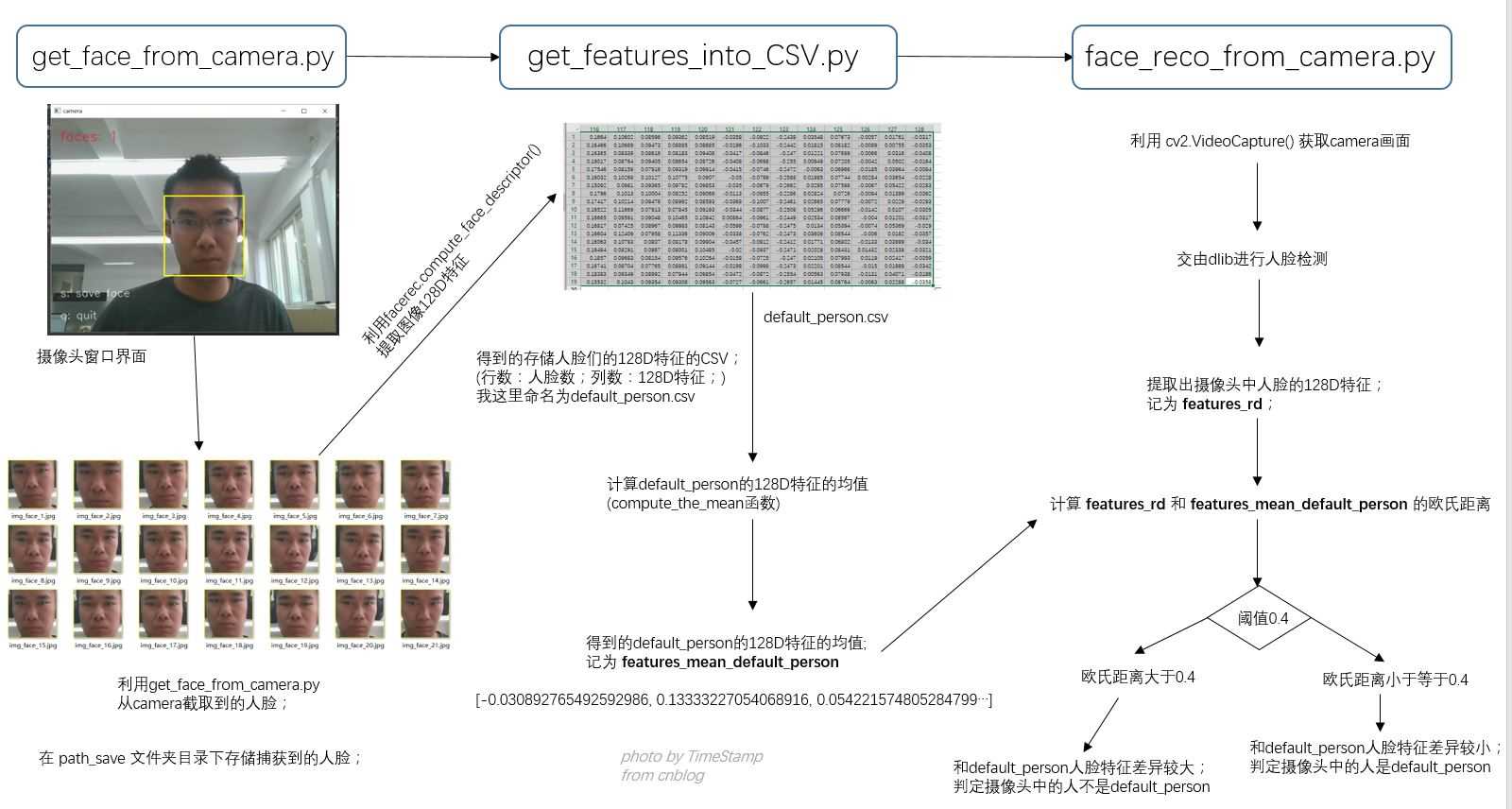
圖2 總體設計流程
2.源碼介紹
主要有
這三個py文件;
2.1get_face_from_camera.py / 采集構建XXX人臉數據
人臉識別需要將 提取到的圖像數據 和已有圖像數據進行比對分析,所以這個py文件實現的功能就是采集構建XXX的人臉數據;
程序會生成一個窗口,顯示調用的攝像頭實時獲取的圖像(關于攝像頭的調用方式可以參考我的另一博客https://www.jb51.net/article/135512.htm);
按s鍵可以保存當前視頻流中的人臉圖像,保存的路徑由 path_save = “xxxx/get_from_camera/” 規定;
按q鍵退出窗口;
攝像頭的調用是利用opencv庫的cv2.VideoCapture(0), 此處參數為0代表調用的是筆記本的默認攝像頭,你也可以讓它調用傳入已有視頻文件;

圖3get_face_from_camera.py 的界面
這樣的話,你就可以在 path_save指定的目錄下得到一組捕獲到的人臉;
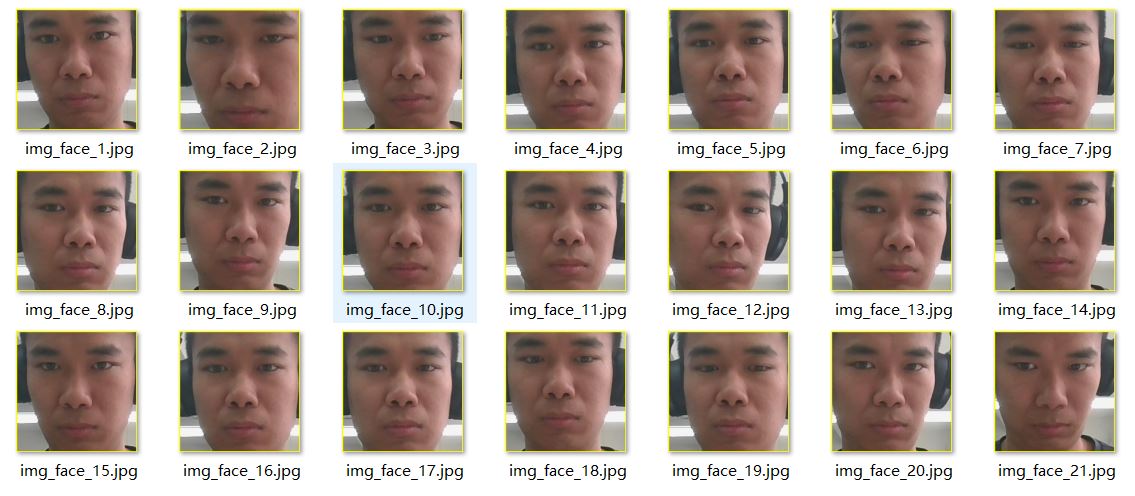
圖4 捕獲到的一組人臉
源碼如下:
# 2018-5-11
# By TimeStamp
# cnblogs: http://www.cnblogs.com/AdaminXie
import dlib # 人臉識別的庫dlib
import numpy as np # 數據處理的庫numpy
import cv2 # 圖像處理的庫OpenCv
# dlib預測器
detector = dlib.get_frontal_face_detector()
predictor = dlib.shape_predictor('shape_predictor_68_face_landmarks.dat')
# 創建cv2攝像頭對象
cap = cv2.VideoCapture(0)
# cap.set(propId, value)
# 設置視頻參數,propId設置的視頻參數,value設置的參數值
cap.set(3, 480)
# 截圖screenshoot的計數器
cnt_ss = 0
# 人臉截圖的計數器
cnt_p = 0
# 保存
path_save = "F:/code/python/P_dlib_face_reco/data/get_from_camera/"
# cap.isOpened() 返回true/false 檢查初始化是否成功
while cap.isOpened():
# cap.read()
# 返回兩個值:
# 一個布爾值true/false,用來判斷讀取視頻是否成功/是否到視頻末尾
# 圖像對象,圖像的三維矩陣q
flag, im_rd = cap.read()
# 每幀數據延時1ms,延時為0讀取的是靜態幀
kk = cv2.waitKey(1)
# 取灰度
img_gray = cv2.cvtColor(im_rd, cv2.COLOR_RGB2GRAY)
# 人臉數rects
rects = detector(img_gray, 0)
# print(len(rects))
# 待會要寫的字體
font = cv2.FONT_HERSHEY_SIMPLEX
if (len(rects) != 0):
# 檢測到人臉
# 矩形框
for k, d in enumerate(rects):
# 計算矩形大小
# (x,y), (寬度width, 高度height)
pos_start = tuple([d.left(), d.top()])
pos_end = tuple([d.right(), d.bottom()])
# 計算矩形框大小
height = d.bottom() - d.top()
width = d.right() - d.left()
# 根據人臉大小生成空的圖像
im_blank = np.zeros((height, width, 3), np.uint8)
im_rd = cv2.rectangle(im_rd, tuple([d.left(), d.top()]), tuple([d.right(), d.bottom()]), (0, 255, 255), 2)
im_blank = np.zeros((height, width, 3), np.uint8)
# 保存人臉到本地
if (kk == ord('s')):
cnt_p += 1
for ii in range(height):
for jj in range(width):
im_blank[ii][jj] = im_rd[d.top() + ii][d.left() + jj]
print(path_save + "img_face_" + str(cnt_p) + ".jpg")
cv2.imwrite(path_save + "img_face_" + str(cnt_p) + ".jpg", im_blank)
cv2.putText(im_rd, "faces: " + str(len(rects)), (20, 50), font, 1, (0, 0, 255), 1, cv2.LINE_AA)
else:
# 沒有檢測到人臉
cv2.putText(im_rd, "no face", (20, 50), font, 1, (0, 0, 255), 1, cv2.LINE_AA)
# 添加說明
im_rd = cv2.putText(im_rd, "s: save face", (20, 400), font, 0.8, (255, 255, 255), 1, cv2.LINE_AA)
im_rd = cv2.putText(im_rd, "q: quit", (20, 450), font, 0.8, (255, 255, 255), 1, cv2.LINE_AA)
# 按下q鍵退出
if (kk == ord('q')):
break
# 窗口顯示
cv2.imshow("camera", im_rd)
# 釋放攝像頭
cap.release()
# 刪除建立的窗口
cv2.destroyAllWindows()
2.2get_features_into_CSV.py / 提取特征存入CSV
已經得到了XXX的一組人臉圖像,現在就需要把他的面部特征提取出來;
這里借助 dlib 庫的 face recognition model 人臉識別模型;
# face recognition model, the object maps human faces into 128D vectors
facerec = dlib.face_recognition_model_v1("dlib_face_recognition_resnet_model_v1.dat")
# detector to find the faces
detector = dlib.get_frontal_face_detector()
# shape predictor to find the face landmarks
predictor = dlib.shape_predictor("shape_predictor_5_face_landmarks.dat")
# 讀取圖片
img = io.imread(path_img)
img_gray = cv2.cvtColor(img, cv2.COLOR_BGR2RGB)
dets = detector(img_gray, 1)
shape = predictor(img_gray, dets[0])
face_descriptor = facerec.compute_face_descriptor(img_gray, shape)
我們可以看下對于某張圖片,face_descriptor的輸出結果:
綠色框內是我們的返回128D特征的函數;
在紅色框內調用該函數來計算img_face_13.jpg;
可以看到黃色框中的輸出為128D的向量;
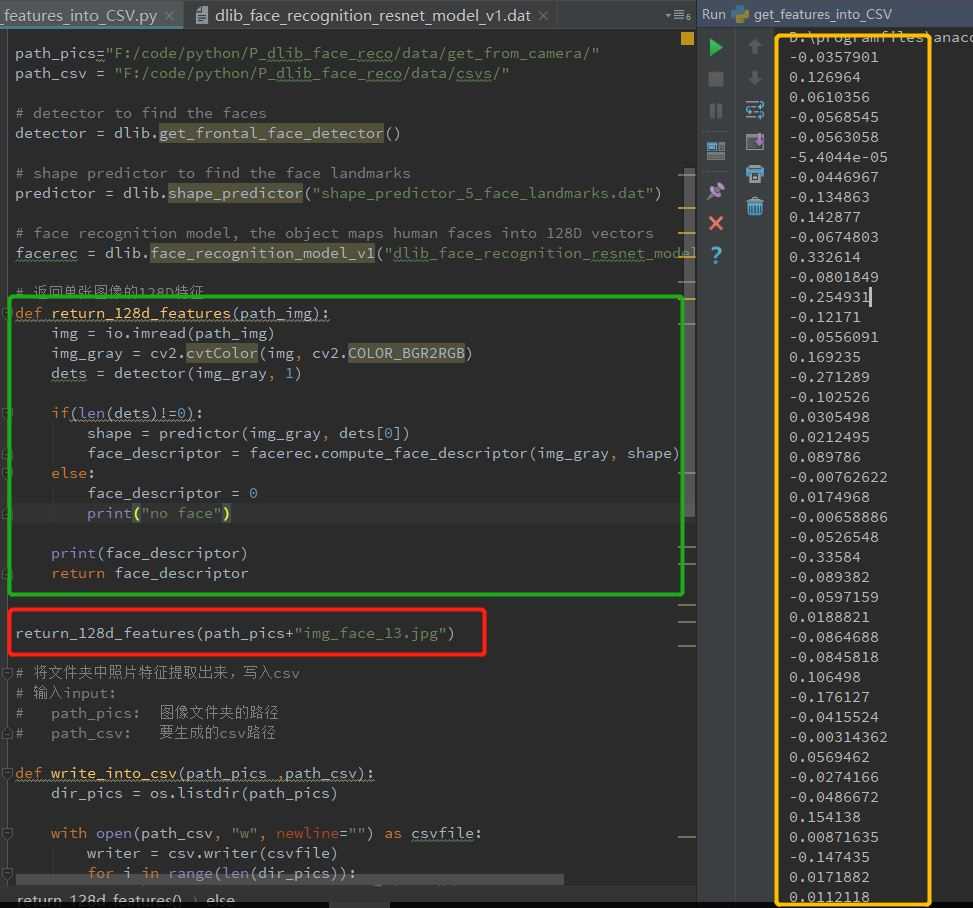
圖5 返回單張圖像的128D特征的計算結果
所以我們就可以把path_save中的圖像,進行批量的特征計算,然后寫入CSV中(利用 write_into_CSV函數),我這邊csv的命名為default_person.csv;
就可以得到行數(人臉數)*128列的一個特征CSV;
這是某個人的人臉特征,然后計算128D特征的均值,求mean(利用 compute_the_mean函數)
運行的輸出結果,這個128D的特征值,就是default_person的特征;
也就是我們內置/預設的人臉,之后攝像頭捕獲的人臉將要拿過來和這個特征值進行比對,進行人臉識別的處理;
源碼:
# 2018-5-11
# By TimeStamp
# cnblogs: http://www.cnblogs.com/AdaminXie
# return_128d_features() 獲取某張圖像的128d特征
# write_into_csv() 將某個文件夾中的圖像讀取特征兵寫入csv
# compute_the_mean() 從csv中讀取128d特征,并計算特征均值
import cv2
import os
import dlib
from skimage import io
import csv
import numpy as np
import pandas as pd
path_pics = "F:/code/python/P_dlib_face_reco/data/get_from_camera/"
path_csv = "F:/code/python/P_dlib_face_reco/data/csvs/"
# detector to find the faces
detector = dlib.get_frontal_face_detector()
# shape predictor to find the face landmarks
predictor = dlib.shape_predictor("shape_predictor_5_face_landmarks.dat")
# face recognition model, the object maps human faces into 128D vectors
facerec = dlib.face_recognition_model_v1("dlib_face_recognition_resnet_model_v1.dat")
# 返回單張圖像的128D特征
def return_128d_features(path_img):
img = io.imread(path_img)
img_gray = cv2.cvtColor(img, cv2.COLOR_BGR2RGB)
dets = detector(img_gray, 1)
if(len(dets)!=0):
shape = predictor(img_gray, dets[0])
face_descriptor = facerec.compute_face_descriptor(img_gray, shape)
else:
face_descriptor = 0
print("no face")
# print(face_descriptor)
return face_descriptor
#return_128d_features(path_pics+"img_face_13.jpg")
# 將文件夾中照片特征提取出來,寫入csv
# 輸入input:
# path_pics: 圖像文件夾的路徑
# path_csv: 要生成的csv路徑
def write_into_csv(path_pics ,path_csv):
dir_pics = os.listdir(path_pics)
with open(path_csv, "w", newline="") as csvfile:
writer = csv.writer(csvfile)
for i in range(len(dir_pics)):
# 調用return_128d_features()得到128d特征
print(path_pics+dir_pics[i])
features_128d = return_128d_features(path_pics+dir_pics[i])
# print(features_128d)
# 遇到沒有檢測出人臉的圖片跳過
if features_128d==0:
i += 1
else:
writer.writerow(features_128d)
#write_into_csv(path_pics, path_csv+"default_person.csv")
path_csv_rd = "F:/code/python/P_dlib_face_reco/data/csvs/default_person.csv"
# 從csv中讀取數據,計算128d特征的均值
def compute_the_mean(path_csv_rd):
column_names = []
for i in range(128):
column_names.append("features_" + str(i + 1))
rd = pd.read_csv(path_csv_rd, names=column_names)
# 存放128維特征的均值
feature_mean = []
for i in range(128):
tmp_arr = rd["features_"+str(i+1)]
tmp_arr = np.array(tmp_arr)
# 計算某一個特征的均值
tmp_mean = np.mean(tmp_arr)
feature_mean.append(tmp_mean)
print(feature_mean)
return feature_mean
compute_the_mean(path_csv_rd)
2.3 face_reco_from_camera.py / 實時人臉識別對比分析
這個py就是調用攝像頭,捕獲攝像頭中的人臉,然后如果檢測到人臉,將攝像頭中的人臉提取出128D的特征,然后和預設的default_person的128D特征進行計算歐式距離,如果比較小,可以判定為一個人,否則不是一個人;
歐氏距離對比的閾值設定,是在 return_euclidean_distance函數的dist變量;
我這里程序里面指定的是0.4,具體閾值可以根據實際情況或者測得結果進行修改;
源碼:
# 2018-5-11
# By TimeStamp
# cnblogs: http://www.cnblogs.com/AdaminXie
import dlib # 人臉識別的庫dlib
import numpy as np # 數據處理的庫numpy
import cv2 # 圖像處理的庫OpenCv
# face recognition model, the object maps human faces into 128D vectors
facerec = dlib.face_recognition_model_v1("dlib_face_recognition_resnet_model_v1.dat")
# 計算兩個向量間的歐式距離
def return_euclidean_distance(feature_1,feature_2):
feature_1 = np.array(feature_1)
feature_2 = np.array(feature_2)
dist = np.sqrt(np.sum(np.square(feature_1 - feature_2)))
print(dist)
if dist > 0.4:
return "diff"
else:
return "same"
features_mean_default_person = [-0.030892765492592986, 0.13333227054068916, 0.054221574805284799, -0.050820438289328626, -0.056331159841073189, 0.0039378538311116004, -0.044465327145237675, -0.13096490031794497, 0.14215188983239627, -0.084465635842398593, 0.34389359700052363, -0.062936659118062566, -0.24372901571424385, -0.13270603316394905, -0.0472818422866495, 0.15475224742763921, -0.24415240554433121, -0.11213862150907516, 0.032288033417180964, 0.023676671577911628, 0.098508275653186594, -0.010117797634417289, 0.0048202000815715448, -0.014808513420192819, -0.060100053486071135, -0.34934839135722112, -0.095795629448012301, -0.050788544706608117, 0.032316677762489567, -0.099673464894294739, -0.080181991975558434, 0.096361607705291952, -0.1823408101734362, -0.045472671817007815, -0.0066827326326778062, 0.047393877549391041, -0.038414973079373964, -0.039067085930391363, 0.15961966781239761, 0.0092458106136243598, -0.16182226570029007, 0.026322136191945327, -0.0039144184832510193, 0.2492692768573761, 0.19180528427425184, 0.022950534855848866, -0.019220497949342979, -0.15331173021542399, 0.047744840089427795, -0.17038608616904208, 0.026140184680882254, 0.19366614363695445, 0.066497623724372762, 0.07038829416820877, -0.0549700813073861, -0.11961311768544347, -0.032121153940495695, 0.083507449611237169, -0.14934051350543373, 0.011458799806668571, 0.10686114273573223, -0.10744074888919529, -0.04377919611962218, -0.11030520381111848, 0.20804878441910996, 0.093076545941202266, -0.11621182490336268, -0.1991656830436305, 0.10751579348978244, -0.11251544991606161, -0.12237925866716787, 0.058218707869711672, -0.15829276019021085, -0.17670038891466042, -0.2718416170070046, 0.034569320955166689, 0.30443575821424784, 0.061833358712886512, -0.19622498672259481, 0.011373612000361868, -0.050225612756453063, -0.036157087079788507, 0.12961127491373764, 0.13962576616751521, -0.0074232793168017737, 0.020964263007044792, -0.11185114399382942, 0.012502493042694894, 0.17834208513561048, -0.072658227462517586, -0.041312719401168194, 0.25095899873658228, -0.056628625839948654, 0.10285118379090961, 0.046701753217923012, 0.042323612264896691, 0.0036216247826814651, 0.066720707440062574, -0.16388990533979317, -0.0193739396421925, 0.027835704435251261, -0.086023958105789985, -0.05472404568603164, 0.14802298341926776, -0.10644183582381199, 0.098863413851512108, 0.00061285014778963834, 0.062096107555063146, 0.051960245755157973, -0.099548895108072383, -0.058173993112225285, -0.065454461562790375, 0.14721672511414477, -0.25363486848379435, 0.20384312381869868, 0.16890435312923632, 0.097537552447695477, 0.087824966562421697, 0.091438713434495431, 0.093809676797766431, -0.034379941362299417, -0.085149037210564868, -0.24900743130006289, 0.021165960517368819, 0.076710369830068792, -0.0061752907196549996, 0.028413473285342519, -0.029983982541843465]
# dlib預測器
detector = dlib.get_frontal_face_detector()
predictor = dlib.shape_predictor('shape_predictor_68_face_landmarks.dat')
# 創建cv2攝像頭對象
cap = cv2.VideoCapture(0)
# cap.set(propId, value)
# 設置視頻參數,propId設置的視頻參數,value設置的參數值
cap.set(3, 480)
def get_128d_features(img_gray):
dets = detector(img_gray, 1)
if (len(dets) != 0):
shape = predictor(img_gray, dets[0])
face_descriptor = facerec.compute_face_descriptor(img_gray, shape)
else:
face_descriptor=0
return face_descriptor
# cap.isOpened() 返回true/false 檢查初始化是否成功
while (cap.isOpened()):
# cap.read()
# 返回兩個值:
# 一個布爾值true/false,用來判斷讀取視頻是否成功/是否到視頻末尾
# 圖像對象,圖像的三維矩陣
flag, im_rd = cap.read()
# 每幀數據延時1ms,延時為0讀取的是靜態幀
kk = cv2.waitKey(1)
# 取灰度
img_gray = cv2.cvtColor(im_rd, cv2.COLOR_RGB2GRAY)
# 人臉數rects
rects = detector(img_gray, 0)
# print(len(rects))
# 待會要寫的字體
font = cv2.FONT_HERSHEY_SIMPLEX
cv2.putText(im_rd, "q: quit", (20, 400), font, 0.8, (0, 255, 255), 1, cv2.LINE_AA)
if (len(rects) != 0):
# 檢測到人臉
# 將捕獲到的人臉提取特征和內置特征進行比對
features_rd = get_128d_features(im_rd)
compare = return_euclidean_distance(features_rd, features_mean_default_person)
im_rd = cv2.putText(im_rd, compare.replace("same", "default_person"), (20, 350), font, 0.8, (0, 255, 255), 1, cv2.LINE_AA)
# 矩形框
for k, d in enumerate(rects):
# 繪制矩形框
im_rd = cv2.rectangle(im_rd, tuple([d.left(), d.top()]), tuple([d.right(), d.bottom()]), (0, 255, 255), 2)
cv2.putText(im_rd, "faces: " + str(len(rects)), (20, 50), font, 1, (0, 0, 255), 1, cv2.LINE_AA)
else:
# 沒有檢測到人臉
cv2.putText(im_rd, "no face", (20, 50), font, 1, (0, 0, 255), 1, cv2.LINE_AA)
# 按下q鍵退出
if (kk == ord('q')):
break
# 窗口顯示
cv2.imshow("camera", im_rd)
# 釋放攝像頭
cap.release()
# 刪除建立的窗口
cv2.destroyAllWindows()
實時輸出結果:
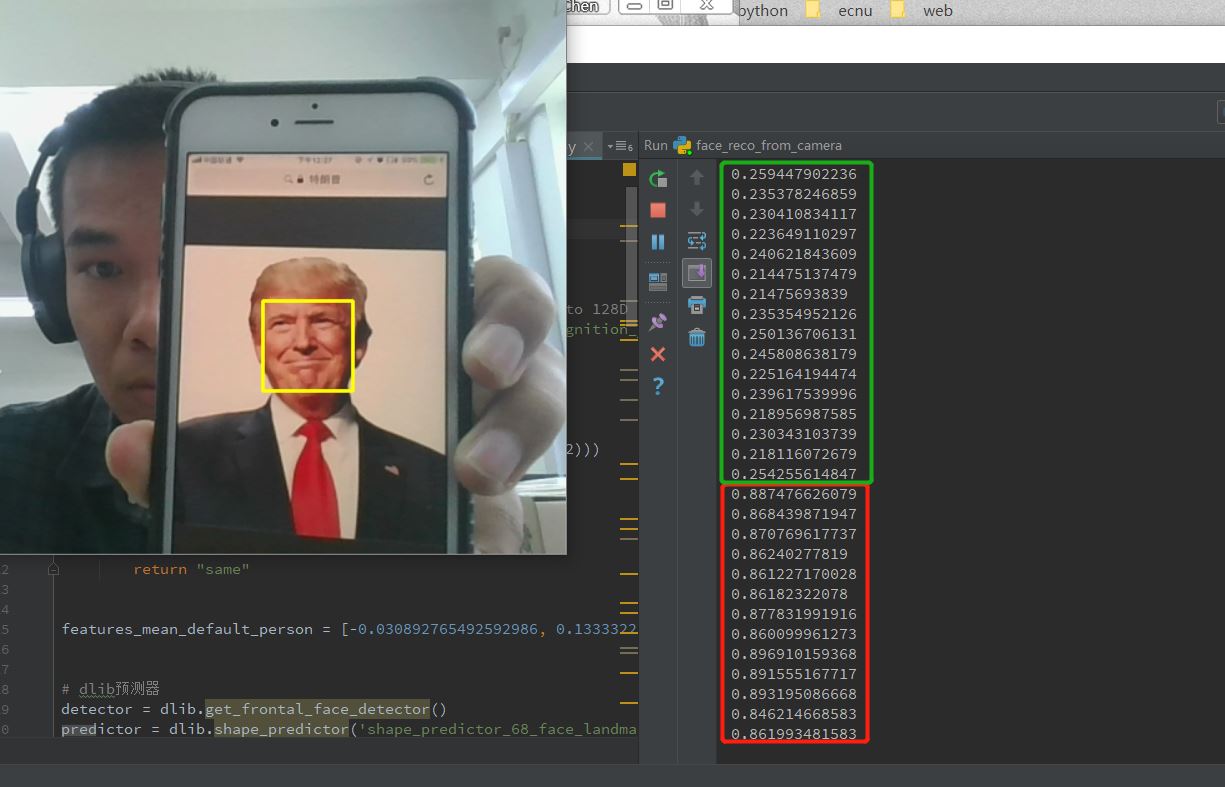
圖6 實時輸出的歐氏距離結果
通過實時的輸出結果,看的比較明顯;
輸出綠色部分:當是我自己(即之前分析提取特征的default_person)時,計算出來的歐式距離基本都在0.2 左右;
輸出紅色部分:而換一張圖片上去比如特朗普,明顯看到歐式距離計算結果達到了0.8,此時就可以判定,后來這張人臉不是我們預設的人臉;
所以之前提到的歐式距離計算對比的閾值可以由此設定,本項目中取的是0.4;
3.總結
之前接著那個攝像頭人臉檢測寫的,不過拖到現在才更新,寫的也比較粗糙,大家有具體需求和應用場景可以加以修改,有什么問題可以留言或者直接mail 我。。。不好意思
核心就是提取人臉特征,然后計算歐式距離和預設的特征臉進行比對;
不過這個實時獲取攝像頭人臉進行比對,要實時的進行計算攝像頭臉的特征值,然后還要計算歐氏距離,所以計算量比較大,可能攝像頭視頻流會出現卡頓;
# 代碼已上傳到了我的GitHub,如果對您有幫助歡迎star下:https://github.com/coneypo/Dlib_face_recognition_from_camera
以上就是本文的全部內容,希望對大家的學習有所幫助,也希望大家多多支持億速云。
免責聲明:本站發布的內容(圖片、視頻和文字)以原創、轉載和分享為主,文章觀點不代表本網站立場,如果涉及侵權請聯系站長郵箱:is@yisu.com進行舉報,并提供相關證據,一經查實,將立刻刪除涉嫌侵權內容。